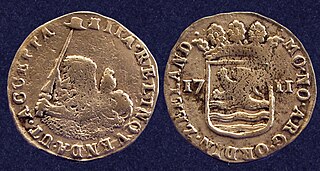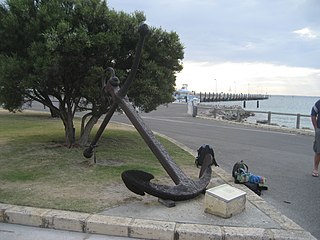Related Research Articles

Batavia ( ) was a ship of the Dutch East India Company (VOC). She was built in Amsterdam in 1628 as the flagship of one of the three annual fleets of company ships and sailed that year on her maiden voyage for Batavia, capital of the Dutch East Indies. On 4 June 1629, Batavia was wrecked on the Houtman Abrolhos, a chain of small islands off the western coast of Australia.

Zuytdorp, also Zuiddorp was an 18th-century trading ship of the Dutch East India Company.

The Zeewijk was an 18th-century East Indiaman of the Dutch East India Company that was shipwrecked at the Houtman Abrolhos, off the coast of Western Australia, on 9 June 1727. The survivors built a second ship, the Sloepie, enabling 82 out of the initial crew of 208 to reach their initial destination of Batavia on 30 April 1728. Since the 19th century many objects were found near the wreck site, which are now in the Western Australian Museum. The shipwreck itself was found in 1968 by divers.

City of York was a 1,167 GRT iron ship which sank after hitting a reef off Rottnest Island in the last few kilometres of its voyage from San Francisco to Fremantle, Western Australia in 1899.

Since the first Europeans visited the west coast of Australia in the 17th century, Rottnest Island has seen numerous shipwrecks. The 11-kilometre-long (6.8 mi) and 4.5-kilometre-wide (2.8 mi) island is surrounded by hidden and partly exposed reefs whilst being buffeted by north-westerly winter gales as well as very strong south-west summer sea "breezes". It is situated 12 kilometres (7.5 mi) west of the port of Fremantle meaning that much of the maritime traffic to Western Australia's major port passes close by.

The Wallabi Group is the northernmost group of islands in the Houtman Abrolhos off the western coast of Western Australia. it is 58 kilometres from the Australian mainland, and about 9 kilometres from the Easter Group.

Gun Island is one of the larger islands in the Pelsaert Group of the Houtman Abrolhos, in the Indian Ocean off the west coast of Australia. It is nominally at 28°53′10″S113°51′35″E, about 4 km (2.5 mi) north and east of Half Moon Reef and is a flat limestone outcrop of about 800 by 420 metres in size. The island is part of the Houtman Abrolhos Important Bird Area, identified as such by BirdLife International because of its importance for supporting large numbers of breeding seabirds.

Lady Elizabeth was a British ship built in 1869 by Robert Thompson Jr. of Sunderland. Robert Thompson Jr. was one of the sons of Robert Thompson Sr. who owned and operated the family ran shipyard J. L. Thompson & Sons. Thompson Jr. eventually left the family business in 1854 to start his own shipbuilding business in Southwick, Sunderland. She was 658 tons and was classified as a barque cargo sailing ship with one deck and three masts. She had a keel and outer planking made from American rock elm and a fore end made from English elm. The stem was made of teak and English oak with an iron floor as the deck. The ship also had copper and iron fastings. The ships was also registered in London under the name Wilson & Co. Messrs Wilson & Co. was based out of Sydney, Australia. The ship carried a comparative classification under American Lloyd's as "First class-third grade"
SS Xantho was a steam ship used in the colony of Western Australia as a pearling transport and mothership, as a tramp steamer, carrying passengers, including Aboriginal convicts and trade goods before she sank at Port Gregory, Western Australia in 1872. She was powered by a horizontal trunk engine.
The Society for Underwater Historical Research (SUHR) was an amateur maritime archaeology organisation operating in South Australia (SA). It was formed in 1974 by recreational scuba divers and other persons to pursue an interest in maritime archaeology and maritime history. The SUHR was renamed as the South Australian Archaeology Society in March 2012 as part of a plan to expand its activities beyond maritime archaeology to include other archaeological disciplines.

RMS Orizaba was a Royal Mail Ship wrecked off Rockingham, Western Australia on 16 February 1905. On her approach to Fremantle, a smog of bushfire smoke was obscuring the coast and the captain lost his bearings. The ship went aground in 6.1 metres (20 ft) of water on Five Fathom Bank, west of Garden Island.
Save Ontario Shipwrecks (SOS) is a Provincial Heritage Organization in Ontario, Canada. SOS is a public charitable organization which operates through Local Chapter Committees supported by a Provincial Board of Directors and Provincial Executive.
The following index is provided as an overview of and topical guide to Wikipedia's articles on recreational dive sites. The level of coverage may vary:

Recreational dive sites are specific places that recreational scuba divers go to enjoy the underwater environment or for training purposes. They include technical diving sites beyond the range generally accepted for recreational diving. In this context all diving done for recreational purposes is included. Professional diving tends to be done where the job is, and with the exception of diver training and leading groups of recreational divers, does not generally occur at specific sites chosen for their easy access, pleasant conditions or interesting features.
References
- Henderson, Graeme (1988–2008). Unfinished Voyages: Western Australian Shipwrecks 1622-1900, 3 Vols. Nedlands, Western Australia: University of Western Australia Press.
- Bateson, C. (1972). Australian Shipwrecks: including Vessels wrecked en route to and from Australia and some strandings . Volume 1 1622-1850. Sydney: Reed.
- Loney, J. (1980–1987). Australian Shipwrecks 1850-1986 3 Vols. Sydney: Reed.